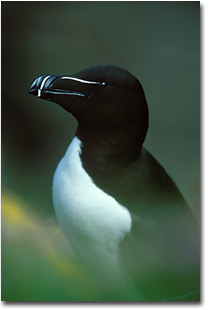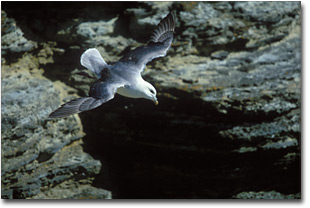To stand at the edge of a cliff with only birds between the sea, lying about 100 m deep under my feet, was an outstanding experience for me. My body was absorbing the experience with all its senses: the screaming of hundreds of thousands of Fulmar, Gullemot, Kittiwake and other birds was mixing with the monotone hitting of sea waves at the beach somewhere deep under my feet and with the blast of the ever present wind. The wind was making the air fresh and sharp, smelling of salt and guano. The eye was moving between the greenness of grass and the greyness of the cliffs patched with green, yellow and red coloured lichens. On the horizon the sea seemed to meet the sky. And the birds were flying from each to every direction.
Handa lies close to the north-western shore of Scotland, about 29 km (18 miles) south of Cape Warth. Boats sail from Tarbeta, a small place located at the end of an uncategorised road that branches off the A 894 Laxford Bridge – Scourie road about 4,8 km (3 miles) north of Scourie (OS ref. NC 13/48, OS map: sheet 9). The boats ply every day, except Sundays, between April 1st and September 10th. The price of a return ticket is about Ł 6 (call Charles Thompson:
 01971 502077 or Stephen MacLeod: 01971 502340). A small contribution for the maintenance of the park, which is paid to the keeper at the island, should be added to that price. The first boat sets out to sea usually at 10 a. m., the last one returns from the island at 5 p. m.. One should keep in mind that the walk from the cliffs to the bay in which the boats are anchored lasts for about 40 minutes, and that the boats don’t wait. The trip to the island can be made only if the weather is fine. For those who intend to take photographs of birds, it is sinful to visit the island between April and the beginning of August, when the mormons return back to the sea.
01971 502077 or Stephen MacLeod: 01971 502340). A small contribution for the maintenance of the park, which is paid to the keeper at the island, should be added to that price. The first boat sets out to sea usually at 10 a. m., the last one returns from the island at 5 p. m.. One should keep in mind that the walk from the cliffs to the bay in which the boats are anchored lasts for about 40 minutes, and that the boats don’t wait. The trip to the island can be made only if the weather is fine. For those who intend to take photographs of birds, it is sinful to visit the island between April and the beginning of August, when the mormons return back to the sea.
After we landed at the southern shore of the island and listened to a short presentation of the park, which is managed by the Scottish Wildlife Trust, we directed our steps towards the northern part of the island where there were about 98,000 pairs of Gullemot Uria aalge, 9,000 pairs of Razorbill Alca torda, 3,000 pairs of Fulmar Fulmarus glacialis and about 700-800 pairs of Puffin Fratercula arctica nesting in the cliffs. We were walking on a wooden footpath, which runs across the moor where there were about 100 pairs of Great Skua Catharacta skua and about 30 pairs of Arctic Skua Stercorarius parasiticus nests. The management of the park appeals to the visitors to keep on the wooden footpath, because Skua are used to people walking along it, but they can be very aggressive if someone would try to get closer to their nests. They act like dive-bombers coming at their enemy in diving attacks aiming with their sharp beaks at the enemy’s highest point – the head. It is not really necessary to leave the wooden footpath if one wants to take a good photograph. What is needed is class 500-mm lenses with at least 1.4 x tele-converter, for there are quite a few nests lying close to the footpath.
The best opportunities for good shots are offered to a bird photographer by the bird colony on the cliffs. The birds are used to the presence of people and a photographer can get so close that the upper part of a Razorbill body fill in the frame even though the longest lenses that you have is not more than 300 mm. One has to keep in mind, however, that the edge of the cliff can break off and meeting the sea about 100 m deeper could be a very unpleasant experience. One of my goals on Handa was to photograph a clown-like Puffin. This bird used to live on Handa, but moved to Great Stack, a rock pillar unconnected with Handa, due to numerous grey rats that used to attack their nests. After deracination occurred in 1997, the first mormones returned to nest on Handa again in 2000. Measuring the light can be a bit tricky due to the black and white colouring, so instead I decided to measure light on the grass surfaces.
It is worth taking photographs of flying members of family Alcidae. Those birds spend most of the time at sea, and their bodies are perfectly built for catching fish. They have stout, cigar like bodies and small wings with which they “fly” under water. A stout body and small wings mean that the relation between the area of wings and the mass of a body is reduced
 and that a bird can fly only if it waves its wings very quickly. Because of that, a flying Puffin resembles a stone flying through the air. They fly along an imaginary straight line, and when a bird photographer manages to define the line the flight can be easily followed with a camera. As the nests are placed pretty close together there is no need to wait for the same bird to return to its nest. There is something happening in the air all the time. Due to the above mentioned relation between the mass of a body and the area of wings Puffins fly pretty fast and quite some experiences are needed if one want to follow them with a camera. A good amount of exercise in taking photograph of a flying bird is offered by Fulmar. I immediately started to like those elegant masters of the wind. They are so good in riding the wind, which blows straight upwards along a cliff, that they make an impression that they float on the same spot in the air. Only a slight movement of a wing or tail makes them shift for a few meters, and again they are floating in the air. Their style of flying makes them easy targets even for an absolute beginner in bird photography.
and that a bird can fly only if it waves its wings very quickly. Because of that, a flying Puffin resembles a stone flying through the air. They fly along an imaginary straight line, and when a bird photographer manages to define the line the flight can be easily followed with a camera. As the nests are placed pretty close together there is no need to wait for the same bird to return to its nest. There is something happening in the air all the time. Due to the above mentioned relation between the mass of a body and the area of wings Puffins fly pretty fast and quite some experiences are needed if one want to follow them with a camera. A good amount of exercise in taking photograph of a flying bird is offered by Fulmar. I immediately started to like those elegant masters of the wind. They are so good in riding the wind, which blows straight upwards along a cliff, that they make an impression that they float on the same spot in the air. Only a slight movement of a wing or tail makes them shift for a few meters, and again they are floating in the air. Their style of flying makes them easy targets even for an absolute beginner in bird photography.
The main difficulty in visiting Handa is late setting out of the boats from Tarbeta and their early return. For this reason, it is not possible to take pictures in warm evening and morning light. Additionally, the black and white colouring of auks feathers makes slightly cloudy weather the most suitable for taking photographs.
Marko Trebušak - NPN 498
Comments on this article? Send them to the editor.

